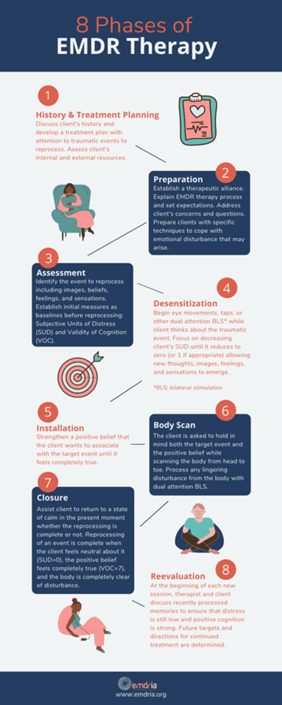EMDR means “Eye Movement Desensitization and Reprocessing.” That’s a mouthful, huh? You may have heard of EMDR before or maybe you’re here because someone recommended this type of therapy to you. But what is EMDR really, who does it help, and how does it work?
What is EMDR? How does it work?
EMDR is a type of therapy that involves rapid eye movements to help a person heal from past traumatic experiences or distressing events. Think about your dream cycle of sleep, REM, or rapid eye movement. This is the period of sleep where human brains try to process and make sense of events from the day. EMDR eye movements simulate this action while awake to help people process and update disturbing memories. With repeated sets of these eye movements, the intensity of these traumatic memories decreases and becomes more neutral. This allows our brain to resume its natural healing process and work through present and future stressors more effectively. EMDR also reduces the physical sensations that often go along with these intense memories.
What will an EMDR session be like?
EMDR is a great therapeutic option because the overall treatment time is often shorter in length than traditional talk therapy. Additionally, the client does not have to talk extensively about the traumatic event they wish to process, which can be very helpful for some individuals who may be hesitant to begin.
EMDR therapy is an eight-phase treatment. While each client’s individual journey will look a little different, EMDR will always follow these 8 phases:
- History taking and treatment planning
- Preparation
- Assessment
- Desensitization
- Installation
- Body Scan
- Closure
- Reevaluation
The first few sessions will be spent with the therapist gathering relevant background and historical information. This is when the client defines what problem or event they wish to focus on in EMDR therapy.
Next, the client and therapist will work to develop resourcing and grounding techniques. This step is important in progressing with EMDR as these techniques help calm our mind and body. Bringing up unpleasant memories or distressing emotions in EMDR sessions can be challenging at times. It is important that the client feels equipped with tools to manage these painful memories and negative emotions both in therapy sessions and out in their daily life.
During the assessment phase of EMDR, the client will define more in depth the problem or event they wish to reprocess. The EMDR therapist will help them identify how that stress is felt in their body and how related negative beliefs might have developed about as a result of that experience.
Next, the desensitization portion of EMDR begins and the client will engage in bilateral stimulation to help desensitize a specific memory or fear they have. These movements engage the right and left sides of the brain and body, which is key in effectively processing distressing events. Bilateral stimulation can be done in multiple ways, including using eye movements, auditory tones, gentle tapping, or tactile tappers. The client will work with the therapist to find the method that works best for them.
Once the desensitization is complete, an EMDR therapist will install and strengthen an adaptive resolution and positive belief that the client wishes to associate with the previously disturbing event. Then, clients are asked to scan their body for any lingering tension connected to the traumatic event. If the client identifies remaining distress in the body, this indicates more processing is needed and the therapist will engage the client in more bilateral movements.
EMDR sessions always end with the closure phase to ensure that the client can return to a state of calm and can assess the need for continuing reprocessing of an event.

What conditions and problems does EMDR treat?
EMDR is an effective treatment for Post Traumatic Stress Disorder (PTSD) and the processing of specific traumatic and disturbing events experienced by the client. For anyone experiencing ongoing trauma-related symptoms, EMDR is likely a good fit.
EMDR is also shown to be an effective form of treatment for many other disorders and complaints that bring people into therapy. Depression, anxiety, panic attacks, eating disorders, and substance abuse are challenges that EMDR can help treat. https://www.emdria.org/about-emdr-therapy/
EMDR can be used in sessions with individuals across the life span, including children, adolescents, and adults.
Why is this treatment used?
EMDR is often used to supplement traditional talk-therapy because it is effective, quick, and yields significant progress in the client’s journey towards healing. EMDR can be used to supplement or in the place of traditional talk therapy when a client is feeling “stuck”. Studies show that 84%-90% of single-trauma victims no longer have post-traumatic stress disorder after only three 90-minute EMDR sessions. (emdr.com) Additionally, one study found that 77% of multiple trauma victims were no longer diagnosed with PTSD after only six 50-minute sessions. (emdr.com)
What now?
You can find more information from the EMDR Institute here.
A very practical way to experience bilateral stimulation in your everyday life is to take a walk when you feel upset about something. You might notice the right and left, back and forth movements of your legs provide a sense of calm and stability you may not have previously had. You can also use slow, soothing touches such as “The Butterfly Hug” to help calm your body in any situation. Check out this video for how to practice butterfly hugs on your own as a positive grounding technique.
If you are interested in learning more and curious if EMDR might be a good treatment option for you, you can schedule a meet and greet session with one of Sentier’s EMDR trained therapists.
Blog written by Sentier therapist Tana Welter, MSW LICSW.












